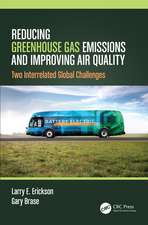Economic and Financial Analysis for Engineering and Project Management
Autor Abol Ardalanen Limba Engleză Paperback – 7 oct 2019
Economic and Financial Analysis for Engineering and Project Management is a "must have" for graduate students in engineering management departments; graduate and undergraduates taking courses in project management, engineering economics, and engineering finance. Practicing engineers will find this book THE handy reference for any project involving financial analyses.
| Toate formatele și edițiile | Preț | Express |
|---|---|---|
| Paperback (1) | 485.18 lei 6-8 săpt. | |
| CRC Press – 7 oct 2019 | 485.18 lei 6-8 săpt. | |
| Hardback (1) | 999.46 lei 6-8 săpt. | |
| CRC Press – 13 oct 1999 | 999.46 lei 6-8 săpt. |
Preț: 485.18 lei
Preț vechi: 570.80 lei
-15% Nou
Puncte Express: 728
Preț estimativ în valută:
92.84€ • 96.93$ • 76.84£
92.84€ • 96.93$ • 76.84£
Carte tipărită la comandă
Livrare economică 05-19 aprilie
Preluare comenzi: 021 569.72.76
Specificații
ISBN-13: 9780367399382
ISBN-10: 0367399385
Pagini: 221
Dimensiuni: 156 x 234 x 13 mm
Greutate: 0.34 kg
Ediția:1
Editura: CRC Press
Colecția CRC Press
ISBN-10: 0367399385
Pagini: 221
Dimensiuni: 156 x 234 x 13 mm
Greutate: 0.34 kg
Ediția:1
Editura: CRC Press
Colecția CRC Press
Public țintă
Academic and Professional Practice & DevelopmentCuprins
Part 1: Financial Analysis & Choice of Alternatives Chapter 1: Introduction Cost and Benefits o Importance of Time (Time Value of Money) o Interest Rate o Continuous Compounding of Interest o Effective Rate of Interest o Nominal Interest Rate o Equivalence o Cash Flow Diagram o Importance of Cash Flow Diagram o The Process of Decision Making o Financial Analysis Methods o Derivation of Formulae: Problems Chapter 2: Present Worth Present Value (PV) o Net Present Worth o Present Value of Uniform Annual Series o Present Value of Series with Arithmetic Gradient o Multiple Alternatives and Equalizing Lives o Exclusivity: Problems Chapter 3: Future Worth Future Value (FV) o Future Value of Uniform Annual Series o Multiple Alternatives o Problems Chapter 4: Annual Worth Annual Worth & Equivalent Uniform Annual Worth o Important Point o EUAW Spreadsheet o Annual Worth of Arithmetic Gradiant Series o Problems Chapter 5: Rate of Return Rate of Return o Multiple Alternatives and Incremental Analysis o Multiple Rate of Returns o Problems Chapter 6: Benefit-Cost Ratio Analysis Benefit Cost Ratio o Equalizing Lives and Incremental Analysis o Payback o Multiple Alternatives: Problems Chapter 7: Inflation and Its Effect on Financial Analysis Inflation and Purchasing Power o Inflation and Interest Rate Combined o Inflation Adjusted Discount Rate: Deflation o General Inflation Indices o Problems Chapter 8: Tax and Depreciation Effects of Income Tax o Depreciation, Book Value, and Capital Gain o Straight Line Depreciation o Double Declining Balance Depreciation (DDB) o Modified Accelerated Cost Recovery System Depreciation o Sum of the Years Digit Depreciation (SOYD) o Change of Depreciation Method o Amortization and Depletion o Financial Analysis with Tax and Depreciation o A Comprehensive Example o Problems Chapter 9: General Comments on Financial Analysis and Problem Solving Applicability of Different Methods o Financial Structure of an Investment o General Structure of Problems o Extra Problems Part 2: Life-Cycle Worth (LCW) Chapter 10: Background and Definitions Background o Life o System Life o Physical Life o Technological Life o Economic Life o Life of Interest and Planning Horizon o Phases of the Life-Time o Phase 1-Concept Formation o Phase 2-Conceptual Design & Development o Phase 3- Design/Engineering, Prototyping & Test o Phase 4-Manufacturing, Test, Packaging and Delivery o Phase 5-Installation, Operation, and Maintenance o Phase 6-Removal, Salvage, or Resale o Concurrent Engineering o Problems Chapter 11: Life-Time Estimation and Calculation Life-Time Cash Flow Diagram o Work Breakdown & Cost Breakdown Structure (CBS) o Life-Time Worth Calculation o Generic WBS o*Life-Time Cost Estimation o Parametric Estimation o Comparative Estimation o Engineering Estimation o Combination of the Estimating Methods o Estimation Accuracy o Universal Ratios o Problems Chapter 12: Software Systems Development and Estimations Introduction o Software Development Process o Requirements Analysis o Preliminary Design o Detailed Design o Implementation o System Test and Acceptance o Software Estimation o Anion-Ardalan Estimation Curve Part 3: Replacement and Retirement Chapter 13: Introduction and Definitions Introduction o Retirement o Opportunity Cost o Replacement o Problems Chapter 14 Replacement Decision Making o Replacement Philosophy o Economic Life and Continuous Replacement o Computerized Determination of the Economic Life o Depreciation & Tax Effects on Replacement o*Replacement Process oMore about Replacement o Prior Knowledge of Replacement Time o Problems Appendix 1: Proof of the Formulae Appendix 2: Interest Tables Index
Descriere
Written by a leading educator in engineering management, this is a basic guide to the financial analysis of executing and sustaining engineering projects. Incorporating both traditional and new approaches, it presents all of the key methods and formulas clearly and concisely and illustrates each one with examples worked with standard spreadsheet software. The analytical tools explained in this book are applicable to projects of any magnitude and in all areas of engineering. The math is kept simple and is fully explained, making the book accessible to non-technical personnel and an ideal text for upper-level students in engineering management, economics, or finance.





























